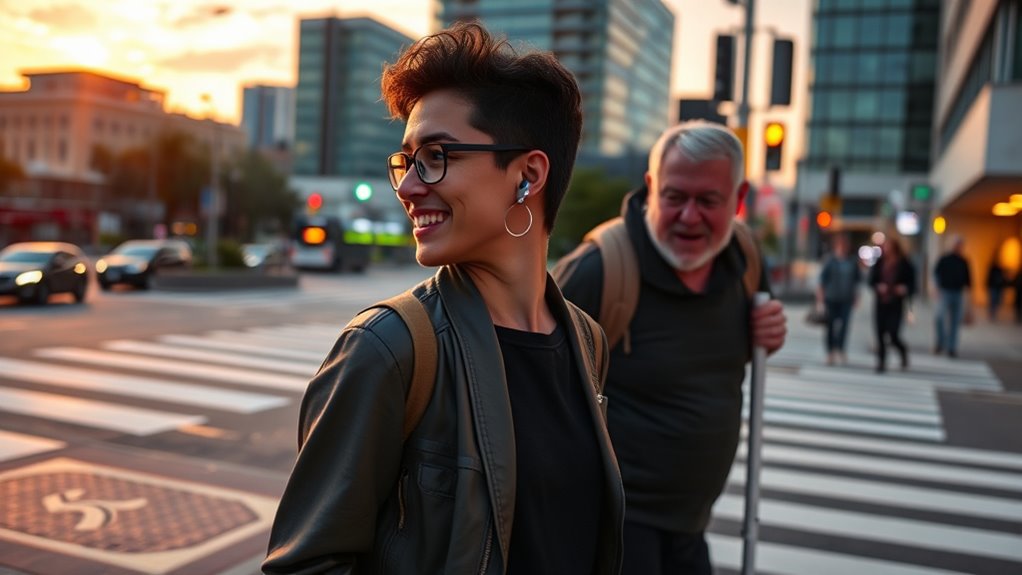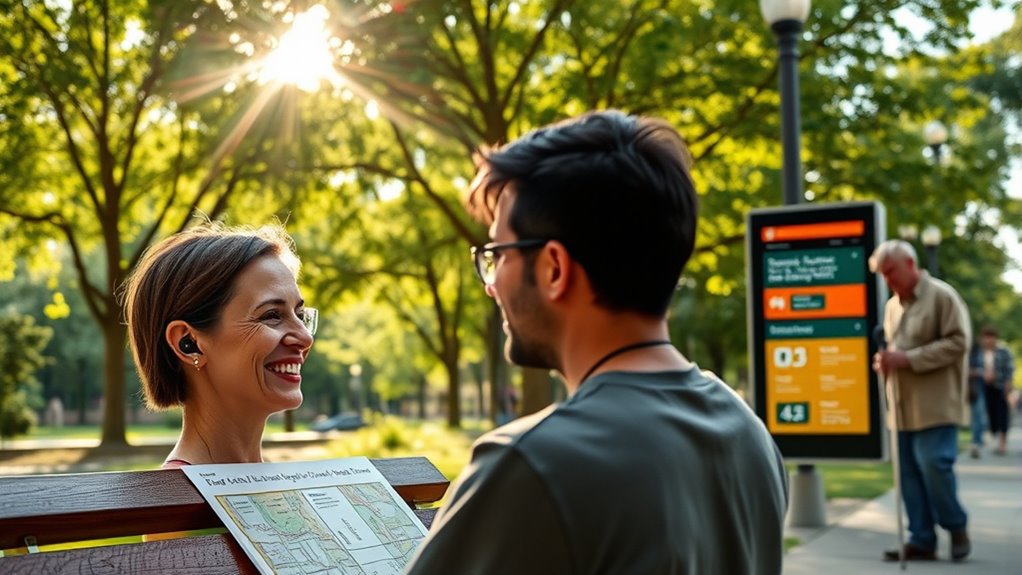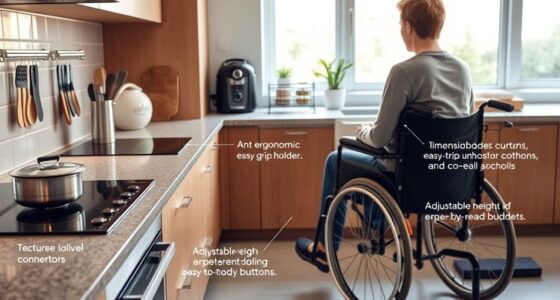Accessibility enhancements like voice commands, tactile feedback, and visual improvements can greatly improve how you experience daily life. Voice controls let you operate devices without needing to see or touch, while tactile feedback confirms actions for better confidence. Visual tweaks like color adjustments can make content clearer and easier to navigate. These small, powerful upgrades turn technology into more inclusive and empowering tools. Keep exploring to discover how these features can transform your daily interactions and independence.
Key Takeaways
- Voice commands enable hands-free device control, improving independence for users with visual or motor impairments.
- Tactile feedback, such as vibrations and textured buttons, provides real-time confirmation and aids users with sensory challenges.
- Combining voice activation and tactile cues creates multi-sensory experiences that enhance overall accessibility.
- Small technological adjustments, like color adjustments and audio descriptions, make digital content more inclusive.
- These innovations transform everyday devices into accessible tools, empowering users to live more independently.

Have you ever considered how small changes can make digital content more accessible? It’s amazing how simple updates can transform experiences for people with sensory differences. For instance, integrating voice commands into devices empowers those with visual impairments to navigate technology more independently. Instead of clicking through menus, you can speak your commands clearly, allowing your device to respond instantly. This hands-free approach minimizes barriers and creates a smoother interaction with smartphones, smart home devices, and computers. Voice commands are more than just a convenience—they’re a vital tool that supports autonomy and confidence for many users.
Small updates like voice commands empower independent, accessible digital experiences for everyone.
Tactile feedback is another powerful feature that enhances accessibility. When you interact with a device, physical sensations like vibrations or textured buttons provide real-time confirmation that your input has been registered. For people with visual impairments or literacy challenges, tactile feedback offers reassurance and prevents errors. For example, a smartphone that vibrates slightly when you press a button ensures you know your command was received, even without looking. This immediate, tangible response helps users stay oriented and reduces frustration, making technology more inclusive. Whether it’s a haptic alert on a fitness tracker or a tactile keyboard with raised keys, tactile feedback bridges the sensory gap and makes digital interactions more intuitive.
By combining voice commands with tactile feedback, you create a multi-sensory experience that caters to diverse needs. For example, a voice-activated assistant can read out information aloud, while tactile cues confirm each step. This dual approach supports users with different abilities, allowing them to choose how they prefer to engage with their devices. It also speeds up interactions, helping you complete tasks more efficiently. When you speak your commands, and your device responds with both a voice and a physical cue, it’s like having a conversation with a helpful companion who understands your needs. These enhancements foster independence and confidence, making everyday technology more accessible and less intimidating.
Ultimately, small changes like implementing voice commands and tactile feedback have a big impact. They turn digital tools from barriers into enablers, allowing you to live, work, and connect more freely. As you explore new accessibility features, you’ll notice how these innovations empower you to overcome sensory challenges and engage with technology on your terms. Making digital content more accessible isn’t about grand overhauls; it’s about thoughtful tweaks that acknowledge and support the diverse ways people experience the world. With these enhancements, technology becomes a more inclusive space where everyone can participate fully and confidently. Incorporating color accuracy and other visual enhancements further enriches the user experience for those with sensory differences, ensuring that digital content is both accessible and engaging.
Frequently Asked Questions
How Affordable Are These Accessibility Technologies for Average Users?
You might wonder about the affordability of these accessibility technologies. A cost analysis shows prices vary widely, but many options are becoming more affordable thanks to advancements and increased competition. You should explore affordability options like government grants, insurance coverage, or sliding scale programs. While some devices are pricey, many essential tools now come at a reasonable cost, making it easier for you to access life-enhancing tech without breaking the bank.
Are These Enhancements Compatible With All Types of Smartphones and Devices?
Device compatibility determines whether these transformative technologies work seamlessly across your smartphone or device. You’ll want to check compatibility specifics, as some enhancements require particular hardware or software updates. While many innovations are designed for broad compatibility, newer features might need the latest software updates to function properly. Always guarantee your device meets the required specifications to enjoy these enhancements fully and avoid compatibility conflicts.
What Training or Support Is Available for New Users of These Technologies?
When you start using these accessibility technologies, you’ll find user onboarding processes designed to help you get comfortable quickly. Support resources like tutorials, FAQs, and customer service are readily available to assist you anytime. These resources guide you through setup, usage, and troubleshooting, ensuring you feel confident. Whether you’re new or experienced, the support system is there to make your conversion seamless and your experience enjoyable.
How Do These Tools Address Privacy and Data Security Concerns?
You might wonder how these tools handle privacy concerns and data security. Rest assured, developers prioritize protecting your information by using encryption and secure data storage. They also implement strict access controls to prevent unauthorized use. Regular updates help address potential vulnerabilities. By choosing trusted brands, you can confidently enjoy these technologies, knowing your personal data remains safe and privacy concerns are actively managed.
Can These Accessibility Features Be Customized for Individual Needs?
You might worry these tools aren’t flexible enough, but they truly are. Customization options allow you to make user-specific adjustments, ensuring the tech fits your unique needs. You can personalize settings to enhance your hearing, sight, or daily life, giving you control and comfort. These features adapt to your lifestyle, making technology not just accessible but empowering, so you feel confident and supported every day.
Conclusion
By embracing these accessibility enhancements, you’re opening up a world where everyone can thrive. Imagine a life where hearing, seeing, and living become more connected and effortless—how different would your daily experiences be? These innovations empower you to break down barriers, creating a more inclusive environment. Isn’t it time we harness technology to make everyday life accessible for all? Together, we can build a future where everyone’s senses are supported and celebrated.









